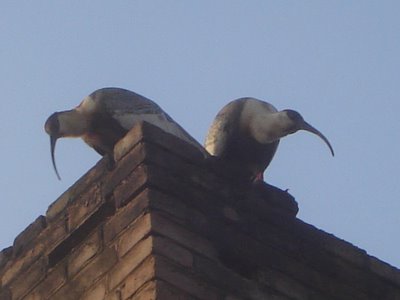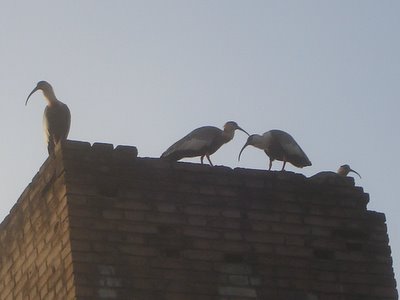

In a beautiful morning my husband and I woke up with a very unusual noise from the top of my house’s water reservoir. My husband hurried up to see what was going on and took some photos. There were four beautiful birds (at that moment we didn’t know their species). Later, searching in Google, I found they were Ibises, White-faced Ibis, or White-faced Glossy-Ibis (scientific name: Plegadis chihi), in Portuguese, Caraúna or Tapicuru. Those lovelies Ibises made a peculiar sound. Click on World Bird Guide to hear their sound.

Ibises are a group of long-legged wading birds in the family Threskiornithidae. They all have long downcurved bills, and usually feed as a group, probing mud for food items, usually crustaceans. Most species nest in trees, often with Spoonbills or Herons.
According to folklore, the Ibis is the last form of wildlife to take shelter prior to a hurricane and the first to reappear after the storm passes. The Ibis was also an object of religious veneration in ancient Egypt, particularly associated with the god, Thoth.

 The family Threskiornithidae includes about 30 species of large terrestrial and wading birds, falling into two subfamilies, the Ibises and the Spoonbills. It was formerly known as Plataleidae. The Spoonbills and Ibises are related to other groups of long-legged wading birds in the order Ciconiiformes, including the Storks, the Herons, and the Bitternss.
The family Threskiornithidae includes about 30 species of large terrestrial and wading birds, falling into two subfamilies, the Ibises and the Spoonbills. It was formerly known as Plataleidae. The Spoonbills and Ibises are related to other groups of long-legged wading birds in the order Ciconiiformes, including the Storks, the Herons, and the Bitternss.They are distributed almost worldwide, being found near almost any area of standing or slow-flowing fresh or brackish water. Ibises are also found in drier areas, including city rubbish tips. All are diurnal and spending the day feeding on a wide range of invertebrates and small vertebrates. At night, they roost in trees near water. They are gregarious, feeding, roosting, and flying together, often in formation.
Till then they don’t show up at my house. I hope to see these beautiful and rare birds again and very soon!
Next post I will introduce another wild bird.
Photos by Carlos Alckmin Mascaro


Sonia, my cat is sleeping at my feet (as usual) and when I clicked on the sounds of the ibises, she woke up quickly and raised up to see what was making the noise. I enjoyed this "lesson" about the ibises.
ReplyDeleteDo you think they will nest Sonia?
ReplyDeleteI can understand why the Egyptians considered them sacred: they're simultaneously eerie and elegant!
ReplyDeleteWow those birds are so big. I love their long bills. I love the unusual things you post about.
ReplyDeleteI live in an area that has a lot of irrigated pasture, and there are always flocks of Ibises in the paddocks, looking for grubs. They are considered an advantage - the grubs would be eating the grass roots, and their digging in the ground aerates the ground.
ReplyDeleteThey are probably one of our commonest birds, although they are probably a different species to yours.
In fact, the emblem for the water authority that administers the large artificial lake that provides the irrigation, is an Ibis.
What a beautiful shape their bills are. Yes, I went to Egypt a few years ago and remember seeing representations of Thoth, the Scribe, with his ibis head ...
ReplyDeleteVous avez toutes les chances :les arbres , les fleurs ,le soleil et maintenant les oiseaux !!
ReplyDeleteCe n'est pas juste ,vous avez trop de chance !!!
You have all the chances:the trees, the flowers,le sun and maintaining the birds!! It is not right, you have too much chance!!!
I am jealous. I've only read about these in stories, and then it was a Scarlet Ibis.
ReplyDeleteI'm beginning to see a reason why I might want to travel outside my own state.
Great description to match the excellent series. Nicely summarised. My fav is the two looking over almost in mirror image.
ReplyDeleteChile was full of the ibis. They were usally in pastures. They were always sooo beautiful to look at. Great pics.
ReplyDeleteSonia, what an incredible bird to wake up to. I am enjoying this post very much--it is a discovery with every visit. Now I will go listen to the ibis...
ReplyDeleteReading Chloe's comment I would say that we're in the same boat. We have many Ibises in Busselton (a recent property development was called Ibis Gardens) and I'm often priviliged to view a flock of them walking around the oval at my kids school.
ReplyDeletesonia-
ReplyDeleteThanks for another interesting post, the pictures are really nice and the sound link was a great idea.
Thanks everyone, for taking the time to look and for the nice comments!
ReplyDeleteWe often have ibis on damp areas of gress here, looking for grubs, no doubt. I believe these are known as the Straw-necked Ibis.
ReplyDeleteThank you Elaine for your nice comment! I appreciate so much it!
ReplyDeleteBEAUTIFUL BEAUTIFUL BEAUTIFUL!!! Oh my, it takes your breath away....Fascinating and so informative Sonia...Thank You!!!
ReplyDeleteOlá Sonia!
ReplyDeleteQue maravilha receber as Caricacas no quintal de casa.
Eu as conheço como Curicacas, nome dado a elas no cerrado e no pantanal.
O canto delas é muito característico!
Mas te pergunto, de novo, me perdoe.. sou um passarinheiro!
Essa fotos são de Theristicus caudatus, Curicaca e não da Caraúna, não é?
Confira em Curicaca veja outras fotos nesse mesmo site.
Vc. conhece xeno-canto.org ??
Lá tem quase todos os cantos de aves do neotrópico!
Bem, vou dormir, amanhã acordo cedo e vou pro mato passarinhar, apesar do frio e da chuva.
Se tiver dúvida com relação a uma ave, me diga e terei o maior prazer em te ajudar!
Continue, seu trabalho é lindo!
[s]